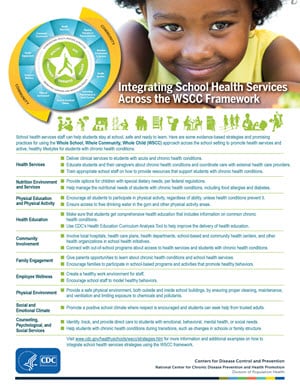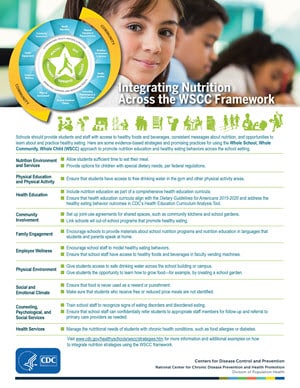| WSCC Component |
Physical Education and Physical Activity Strategies |
| Physical Education and Physical Activity |
- Implement policies and practices that support a Comprehensive School Physical Activity Program, including physical education, recess, classroom physical activity, intramurals, physical activity clubs, walk- and bicycle-to-school initiatives, and interscholastic sports.
- Implement policies and practices that support physical education, such as:
- Requiring daily physical education.
- Having a written curriculum.
- Providing opportunities for certification licensure for PE teachers.
- Making sure students get moderate-to-vigorous physical activity for at least 50% of class time.
- Prohibiting the withholding of physical education or the use of physical activity as a punishment.
|
| Health Education |
- Include physical activity as part of comprehensive health education.
- Ensure that health education curricula align with the national and state standards for physical education and address the physical activity behavior outcomes in CDC’s Health Education Curriculum Analysis Tool.
- Reinforce the information taught in physical education classes and provide opportunities for students to apply it.
|
| Community Involvement |
- Establish partnerships between schools and local government to create joint-use agreements to allow public access to school facilities, fitness centers, gymnasiums, or running tracks.
- Link to out-of-school programs that promote physical activity.
- Involve community organizations in school initiatives on physical education and physical activity.
- Leverage community resources to purchase equipment and safety gear, create safer environments for play such as safe playgrounds, and provide physically active transportation to school, such as traffic interventions.
|
| Family Engagement |
- Provide materials about physical education and physical activity in languages that students and parents speak at home.
- Involve families on the school health council and engage them in promoting policies and practices for physical education and physical activity.
- Survey the interests of families to help offer needed physical activity initiatives.
- Encourage family members to volunteer in physical education classes or other physical activity programs.
|
| Employee Wellness |
- Encourage school staff to model physical activity behaviors.
- Provide staff with access to physical activity opportunities through staff wellness programs.
- Provide physical activity breaks during staff meetings.
- Develop, implement, and evaluate physical activity programs for all school employees.
|
| Physical Environment |
- Assess, inspect, and maintain all spaces and facilities for physical activity, including playing fields, playgrounds, gyms, swimming pools, multipurpose rooms, and fitness centers.
- Ensure safe routes to school.
- Provide safe and age-appropriate playgrounds and equipment for physical education, physical activity, and recess during the school day.
- Post safety rules and teach them to students.
- Provide students with protective clothing and equipment appropriate for the type of physical activity and the environment.
|
| Social and Emotional Climate |
- Establish social norms that increase physical activity behaviors of students and staff members, such as morning physical activity for all over intercom system.
- Establish policies and practices that allow full participation by all students in physical activity and physical education.
- Do not use physical activity as punishment or withhold opportunities for physical activity as a form of punishment.
|
| Counseling, Psychological, and Social Services |
- Assess student needs related to physical activity and provide counseling and other services to meet those needs.
- Help students overcome barriers to physical activity and help them find social support, cope with teasing, set goals, and make healthy decisions.
|
| Health Services |
- Refer students with physical activity concerns to health services staff members.
- Encourage collaboration between health staff members and physical education teachers to establish a healthy environment that promotes physical activity messages and activities.
- Implement individualized health plans established for students with chronic health conditions and encourage them to participate fully in structured and unstructured physical activity.
|
| Nutrition Environment and Services |
- Ensure access to free drinking water in the gym and other physical activity areas.
- Promote only healthy foods; physical activity, such as dance-a-thons; or nonfood items for school sports or physical education program fundraisers.
|




